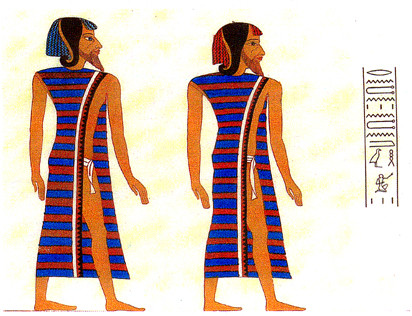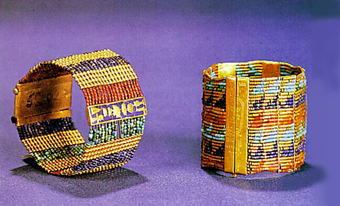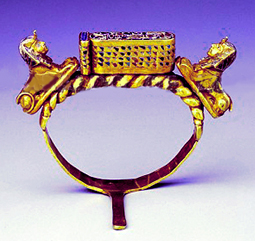Articoli
THE HAUNEBUTS AND THE QUEEN OF ATLANTIS
LIBYAN BERBERS, TJEHENU, TEMEHU, HAUNEBUTWe must not mislead by the fact that today we call Atlantic Ocean the wide expanse of water, west to European coasts. This correspondence of names is often invoked as evidence, by the supporters of an Atlantis placed in the Caribbean, or around the Azores, and plunged to the darkest oceanic pits.
Pytheas, thirty years after the death of Plato, was the first to indicate as Okeanos the vast expanse of western sea, and then throughout the middle ages it was called "Sea of Storms" or "of Darkness".
In 150 AD, the famous Geography of Ptolemy designated it as the "western ocean". The name Atlantic Ocean was adopted much later, between the 16th and 17th centuries, after the "discovery" of America, that in a first moment was just baptized "Atlantis". It is therefore misleading and false consideration (by many invoked in support of their hypothesis) that the name given in recent times to the Atlantic Ocean should indicate the location of the ancient Atlantis.
There is an oral tradition of Berber people that calls "Bahr Atala", i.e. "Sea of Atlantis", the region of the Shott el Jerid, the bottom of the ancient great lake whose overflow, according to my studies and my hypothesis, was the cause of the real destruction of Atlantis.
From immemorial times the western sailors, who had been forced to move to and from their islands, had learned to sail on the high seas. They had explored the Mediterranean, had settled in the Cyclades and Crete, before that time almost uninhabited, and from there they ran their fruitful trade with Egypt.
It can be argued that this type of sea-wolves would not go unnoticed!
Well, in Egypt they knew very well those seamen, who were neither Syrian, nor Cretans, nor Mycenaeans. Since Cheops, about 2600 BC, the texts allude to the mysterious seamen. Traders, pirates, mercenaries, from time to time, the 'north wind' prompting them from distant seas until the western branches of the Delta: they were called Haunebuts.
The texts of the Pyramids, dated 2500 BC, called the Mediterranean Sea 'the circle surrounding the Haunebuts' or even 'the verdant of Haunebut'. One of the ‘nine Arcs’, i.e. the regions of the Universe dominated by Pharaoh, was called the 'Arc of Haunebuts'. About these nine arches we find memories since the Scorpion King, before the year 3000 BC. Therefore the Haunebuts had to exist before Byblos, Mycenae, before the Greeks and even before the Egypt!
Various authors see in this term a mythical and generic expression, attributing the name from time to time to the sea-peoples coming from the North. Haunebuts were not, however, a mythical expression. Temehu and Tjehenu are mentioned from the earliest known Egyptian texts, about 3200 BC. They appear painted in the temple of Sahure, about 2500 BC. Tjehenu are high, good posture, with a rich hair, aquiline nose and a painter to tip. Their skin is white. In this painting they are dressed only with necklaces and other ornaments and a small loincloth.
Between 2200 and 2050 BC, populations of Asian origins, pushed in the Delta of the Nile by the Amorites, begot a state of anarchy, coyly renamed in Egyptian history as “the first intermediate Period”. The following period of the Middle Kingdom was a new brilliant era, for the glories of Egypt, but in 1780 there was a return to power of Asian populations, that began in the second intermediate Period. This time the Asians were achieved by their invaders, who organized a kingdom in the eastern region of the Nile Delta, with the city of Avaris as capital. Six Pharaohs reigned there, between 1645 and 1537. Egyptians called those foreigners Hyksos, a term that has long been translated as "shepherd kings", while today we admit a meaning "heads of foreign countries". Their origin remains unknown. (Note 1)
For the official history the origin of the Hyksos remains a mystery, but their departure from Egypt is well documented by the texts.
The Theban king Seqemenre undertaken in 1580 an expedition toward the northern territories, against the Hyksos Apophis, continued by his son Kames (Kamose). Between 1557 and 1548 the great Ahmes (Ahmose, Ahmosis), brother of Kames, conquered Avaris and free the Delta, thus founding the New Kingdom.
With what forces the Pharaohs of the South succeeded to defeat foreigners? A text recalls: "Kames launch the first attack with the help of the Nubian bedouins". Pharaoh Ahmose succeeded in conquering Delta thanks to a naval operation, and we know that two of his ships were called "Furious Bull" and "The Nordic". (Note 2) There is a strong suggestion that the expert Haunebut sailors, who settled in the western part of the Delta, have given a strong hand to the Theban Pharaoh, and they were well known at the Egyptians for both their veneration of the bull, and their 'northern' origins. Another text relates that the liberator Ahmose made his subjects applaude his bride, the 'Lady of Haunebut', and the Stele of the Victory proclaims the equivalence between the Haunebut and the egyptian nobility. Pierre Montet concludes that the Haunebuts were allies of Pharaoh, in the battle for the conquest of the Delta. (Note 3)
In the tomb of queen Ahhotep, wife, or perhaps mother of Ahmose, called 'Sovereign of the banks of Haunebuts', (Note 4) three damascened daggers were found, together with the ax of the Pharaoh. The decoration of daggers is decidedly of a 'Mycenaean' type and the hieroglyphs etched on blades are rather imprecise. It must be therefore a gift offered to Pharaoh by foreigners, and we know also that his rival Apophis gave to his official 'Aegean' daggers. The Mycenaean civilization, as we know it, did not exist, however, before 1550 BC, and the Treasures found in its fortresses are attributed to achievements by the legendary Danaos against the surrounding peoples. All this reinforces the hypothesis that it is the art of Haunebuts, then masters of Mediterranean routes, allies to Pharaoh Ahmose, a people to which the Queen herself belonged.
Deruelle observes the correspondence of this hypothesis with the myth of Io. Zeus that seduces Io, daughter of Argolida, represents the control of Elleni in that territory, where in 1650 they left swords, amber and rhinestones in the Mycenaean tombs. The country, however, was poor and cattle farmers traveled everywhere (in the myth, Io fled unceasingly), until, in the Caucasus, Prometheus suggested her to go to Egypt. Here, the mythical Heifer became the mother of the king of Egypt Epaphos, who would correspond to the Hyksos Apophis. (Note 5)
It is clear that since very ancient times a maritime power dominated the Mediterranean Sea and that the Egyptians ignored its provenance.
In 1307 BC, 80 years before the arrival of the Sea Peoples, Claire Lalouette indicates an attack in Libya by newcomers, blond and blue-eyed, that the Egyptians called Tjehenu.
The Libu (Libyans), successors of Temehu and Tjehenu, are depicted in Egyptian paintings dressed with long embroidered cloaks, with a single sleeve (the right one), tattooed, with feathers in her hair, part of the skull shaved and a long braid that falls above the right ear. In 1300 BC, in the tomb of Setis I, they are depicted their splendid costumes. A sculpture of the times of Ramses II (1290-1224) represents the typical head of a Libyan, with the braid.
In an inscription of the pylon of his funerary Temple, at Medinet Habu, Ramses III is glorified by the divinity: "I put the fear of thee in the heart of the earth of Haunebut. Your Majesty crushed them... the sand sea-rovers shall bow down before thy name".
In the 12th century BC, after the raids of the Peoples of the Sea, the Libyan kings went up on the throne of Egypt.
The name of the Meshuesh, one of the groups appointed between the peoples of the Sea, resembles closely to the terms of Massyles and Masaesyles, berber peoples who opposed strenuously to Carthage and then to Rome. The Romans called them Mazices, Herodotus pointed to them as Maxyes. Even today, the Berbers call themselves with the term Amazigh. The Meshuesh were probably the most ancient inhabitants of the Maghreb.
We stop here, for the moment, in this chapter, which leads us to rediscover the traces of the Atlantis in the Mediterranean of the second millennium BC and to identify the mythical lost kingdom as the cradle of the culture of the bronze age, the architect of the construction of the megaliths and the bearer of the cult of the Great Mother Goddess.
NOTES
Alberto Arecchi, architect, art historian, president of the cultural Association Liutprand (www.liutprand.it), studied for years the hypothesis of Atlantis placed in the center of the Mediterranean Sea. On this theme he published a book (Atlantide, ed. Liutprand, 2001).
1 – W. HELCK, Die Beziehungen Ägyptens zu Vorderasien in 3. und 2. Jahrtausend, Harrassowitz, Wiesbaden, 2. Ed., 1971; ID., Die Beziehungen Ägyptens und Vorderasiens zu Ägäis, Erträge des Forschung, Wissenschaftliche Buchgesellschaft, Darmstadt, dez. 1979.
2 – W. HELCK, Die Beziehungen Ägyptens zu Vorderasien in 3. und 2. Jahrtausend, Harrassowitz, Wiesbaden, 2. Ed., 1971, p. 112.
3 – P. MONTET, L’Egypte éternelle, Marabout, Fayard, 1970, p. 142.
4 – Urk. IV, 21, G. VANDERSLEYEN, Les guerres d’Amosis, in Monographie de la reine Elisabeth, 1971, p. 135.
5 – R. GRAVES, Les mythes grecs, Fayard, 1967, 56b.




